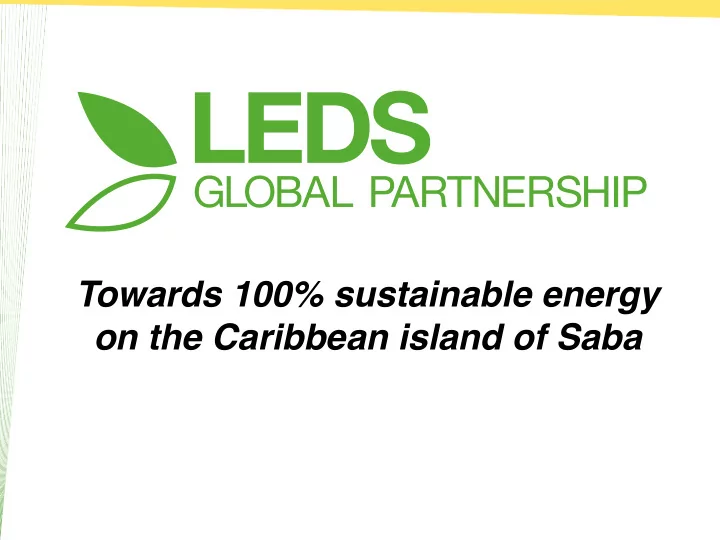

Towards 100% sustainable energy on the Caribbean island of Saba
On Saba, challenges to sustainable, environmentally resilient development include: • an over-dependency on food and fuel imports • insecurity of energy supply. ¡ Saba island
Electricity supply depends entirely on one diesel power plant located close to sea level by the harbour. 50% of the cost of electricity is related to the volatile price of fossil fuels and lubricants. Consumers pay a subsidised rate 35% below the cost of production. Saba power plant
The Government of Saba has made the decision to transform the island to 100% sustainable energy and eventually eliminate dependence on fossil-fuel- generated electricity. ¡ Intermediate targets for renewable electricity are: • 20% by 2017 • 40% by 2020
Technical studies Analysis Stakeholder consultation Consensus building SABA’S ENERGY POLICY Equitable access and quality of energy for all sectors of society, particularly the poor
The implementation of Saba’s energy policy has been considered a success. Two energy projects are being implemented thanks to a private—public partnership between the Dutch Government and the local Saba Electric Company NV (SEC).
The fj rst investment is related to security of supply. The current diesel power plant is being upgraded with modern, more e ffi cient engines. It is also being relocated to an area less vulnerable to fm ooding and other natural disasters. ¡
The second investment is the construction of the fj rst 1 MW photovoltaic solar system on the island. This renewable energy system will be operating by the end of 2016 and will provide Saba with 20% of its energy needs.
Between 2013 and 2015, the energy sector reform received Dutch grants to reduce the risks of SEC losing money in its operations. Technical guidance in the form of analysis and studies have been provided by the Dutch Government to facilitate implementation of the policy.
The successful implementation of Saba’s energy policy provides four lessons to other islands: 1. Public—private partnerships are a viable fj nancing mechanism for the transition from a fossil-fuel-based system to renewable energy sources. 2. Low-risk o ff -the-shelf technology solutions are available, rather than taking the risk of using untested new technologies.
3. Analyze best practices: Photovoltaic systems are currently preferred in the absence of technologies to protect wind energy equipment from hurricane damage. 4. Choose a business model: A prosumers model (businesses/households both produce and consume electricity) is too high risk for Saba’s small size. The more conventional business model adopted o ff ers fj rmer guarantees.
Want to know more? Download the full case study from the Subnational Integration Working Group of the Low Emission Development Strategies Global Partnership (LEDS GP) here: http://ledsgp.org/resource/towards-100-sustainable-energy-on- caribbean-island-saba/ For more information, get in touch with the Subnational Integration Working Group at sniwg@ledsgp.org.
Join us! Build your technical expertise through peer exchange and training… Access pro bono technical assistance on LEDS (for developing country governments)… Contact LEDS donors and project developers… Go to ledsgp.org/join/ ¡
Image credits • Saba island • Saba power plant • A woman attends her produce post in a market in zone 3, Guatemala City. Photo: Maria Fleischmann / World Bank • Working at E-Power plant in Port-au-Prince. Photo: Dominic Chavez / World Bank • Mother and child on a farm. Photo: Maria Fleischmann / World Bank • Produce market. Photo: Maria Fleischmann / World Bank • Saba • Construction works. Photo: Gerardo Pesantez / World Bank • Working at E-Power plant in Port-au-Prince. Photo: Dominic Chavez / World Bank • Lopburi solar power plant, central Thailand. Photo: Asian Development Bank • Solar panels. Photo: Julia Manzerova • Women involved in community meeting to discuss village reconstruction. Photo: Nugroho Nurdikiawan Sunjoyo / World Bank
Recommend
More recommend